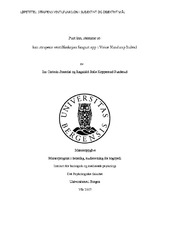| dc.contributor.author | Funderud, Ragnhild Sofie Kopperstad | |
| dc.contributor.author | Smørdal, Ina Christin Lundstrøm | |
| dc.date.accessioned | 2017-07-31T12:33:17Z | |
| dc.date.available | 2017-07-31T12:33:17Z | |
| dc.date.issued | 2017-06-14 | |
| dc.date.submitted | 2017-06-13T22:00:15Z | |
| dc.identifier.uri | https://hdl.handle.net/1956/16155 | |
| dc.description.abstract | In order to produce voice, one needs breath, and breath is therefore a fundamental element within the field of voice. The purpose of this study is to investigate whether correlation exists between the aerodynamic parameter of maximum phonation time and the Norwegian version of the self-evaluation form Voice Handicap Index (VHI-30(N)). VHI-30(N) shows the level of voice difficulty as experienced by the patient. In order to say anything about what voice difficulty is, this study will first look at knowledge on the anatomic starting point for voice production and respiration. The study is based on a control group and a patient group, and in the introduction, one will attend to the four conditions of illnesses in the patient group; Reinkes edema, recurrensparese, functional voice difficulties and degenerative/inflamatorical diagnoses. The correlation between these groups of diagnoses will later be analyzed and discussed in the article. Question 2 in VHI-30(N), “I run out of air when I talk”, revolves around function of breath, in the same way as with maximum phonation time. Therefore, this study will take a closer look at whether these two measurements can correlate. Through focus on previous research within the field of voice and on the two instruments of measure used by the study, the study will present clinical usefulness in the daily clinical use of voice evaluation. | en_US |
| dc.description.abstract | For å kunne produsere stemme treng ein pust, og pusten er difor eit grunnleggande element innan stemmefeltet. Førmålet med denne studien er å undersøke om det er korrelasjon mellom det aerodynamiske parameteret maksimal fonasjonstid og den norske versjonen av sjølvevalueringsskjemaet Voice Handicap index (VHI-30(N)). VHI-30(N) viser pasienten si sjølvopplevde grad av stemmevanske. For å kunne seie noko om kva ei stemmevanske er, vil studien først ta for seg kunnskap om det anatomiske utgangspunktet for stemmeproduksjon og respirasjon. Studien tek utgangspunkt i ei kontrollgruppe, og ei pasientgruppe, og under introduksjonen vil ein ta for seg dei fire sjukdomstilstandane i pasientgruppa; Reinkes ødem, recurrensparese, funksjonelle stemmevanskar og degenerative/inflammatoriske diagnosar. Det er korrelasjonen mellom desse diagnosegruppene som seinare vil bli analysert og diskutert i artikkelmanuset. Spørsmål 2 i VHI-30(N) “Jeg går tom for luft når jeg snakker”, omhandlar pustefunksjon, på lik linje med maksimal fonasjonstid. Det vil difor i denne studien bli sett nærare på om desse to måla kan korrelere. Gjennom fokus på tidlegare forskning på stemmefeltet og på dei to måleinstrumenta studien tek for seg, vil studien rette fokus på klinisk nytteverdi i den kliniske kvardagen med stemmeevaluering. | en_US |
| dc.language.iso | nno | eng |
| dc.publisher | The University of Bergen | eng |
| dc.subject | stemmevansker | eng |
| dc.subject | respirasjon | eng |
| dc.subject | logopedi | eng |
| dc.subject | pust | eng |
| dc.subject.mesh | Respiration | eng |
| dc.subject.mesh | Voice Disorders | eng |
| dc.subject.mesh | Voice | eng |
| dc.title | Pust inn, stemme ut- kan strupens ventilfunksjon fangast opp i Voice Handicap Index? | eng |
| dc.type | Master thesis | |
| dc.date.updated | 2017-06-13T22:00:15Z | |
| dc.rights.holder | Copyright the Author. All rights reserved | eng |
| dc.description.degree | Masteroppgåve i logopedi | |
| dc.description.localcode | LOGO345 | |
| dc.description.localcode | MAPS-LOG06 | |
| dc.subject.nus | 799999 | eng |
| dc.subject.nsi | VDP::Samfunnsvitenskap: 200::Psykologi: 260::Biologisk psykologi: 261 | |
| fs.subjectcode | LOGO345 | |
| fs.unitcode | 17-32-00 | |
